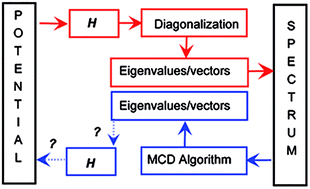当前位置:
X-MOL 学术
›
Faraday Discuss.
›
论文详情
Our official English website, www.x-mol.net, welcomes your feedback! (Note: you will need to create a separate account there.)
Teaching vibrational spectra to assign themselves
Faraday Discussions ( IF 3.4 ) Pub Date : 2018-05-21 , DOI: 10.1039/c8fd00075a Paul L. Houston 1, 2, 3, 4, 5 , Brian L. Van Hoozen 4, 6, 7, 8, 9 , Chen Qu 4, 6, 7, 8, 9 , Qi Yu 4, 6, 7, 8, 9 , Joel M. Bowman 4, 6, 7, 8, 9
Faraday Discussions ( IF 3.4 ) Pub Date : 2018-05-21 , DOI: 10.1039/c8fd00075a Paul L. Houston 1, 2, 3, 4, 5 , Brian L. Van Hoozen 4, 6, 7, 8, 9 , Chen Qu 4, 6, 7, 8, 9 , Qi Yu 4, 6, 7, 8, 9 , Joel M. Bowman 4, 6, 7, 8, 9
Affiliation

|
A new paradigm for assigning vibrational spectra is described. Instead of proceeding from potential to Hamiltonian to eigenvalues/eigenvectors/intensities to spectrum, the new method goes “backwards” directly from spectrum to eigenvectors. The eigenvectors then “assign” the spectrum, in that they identify the basis states that contribute to each eigenvalue. To start, we demonstrate an algorithm that can obtain useful estimates of the eigenvectors connecting a real, symmetric Hamiltonian to its eigenvalues even if the only available information about the Hamiltonian is its diagonal elements. When this algorithm is augmented with information about transition intensities, it can be used to assign a complex vibrational spectrum using only information about (1) eigenvalues (the peak centers of the spectrum) and (2) a harmonic basis set (taken to be the diagonal elements of the Hamiltonian). Examples will be discussed, including application to the vibrationally complex spectral region of the formic acid dimer.
中文翻译:

教授振动光谱以进行自我分配
描述了一种分配振动光谱的新范例。新方法不是从势能到哈密顿量再到特征值/特征向量/强度再到频谱,而是直接从频谱“回归”到特征向量。特征向量然后“分配”频谱,因为它们确定了有助于每个特征值的基本状态。首先,我们演示了一种算法,该算法可以获取将真实的对称哈密顿量与其特征值连接起来的特征向量的有用估计,即使有关哈密顿量的唯一可用信息是其对角元素。当此算法增加了有关转换强度的信息时,仅使用有关(1)特征值(频谱的峰值中心)和(2)谐波基集(被视为哈密顿量的对角线元素)的信息,就可以使用它分配复杂的振动频谱。将讨论实例,包括应用于甲酸二聚体的振动复杂光谱区域。
更新日期:2018-12-21
中文翻译:

教授振动光谱以进行自我分配
描述了一种分配振动光谱的新范例。新方法不是从势能到哈密顿量再到特征值/特征向量/强度再到频谱,而是直接从频谱“回归”到特征向量。特征向量然后“分配”频谱,因为它们确定了有助于每个特征值的基本状态。首先,我们演示了一种算法,该算法可以获取将真实的对称哈密顿量与其特征值连接起来的特征向量的有用估计,即使有关哈密顿量的唯一可用信息是其对角元素。当此算法增加了有关转换强度的信息时,仅使用有关(1)特征值(频谱的峰值中心)和(2)谐波基集(被视为哈密顿量的对角线元素)的信息,就可以使用它分配复杂的振动频谱。将讨论实例,包括应用于甲酸二聚体的振动复杂光谱区域。


























 京公网安备 11010802027423号
京公网安备 11010802027423号